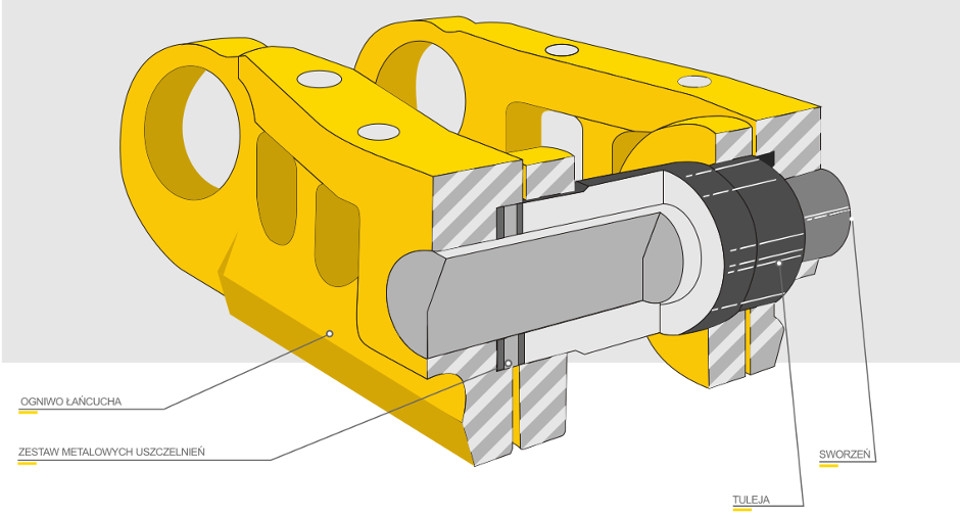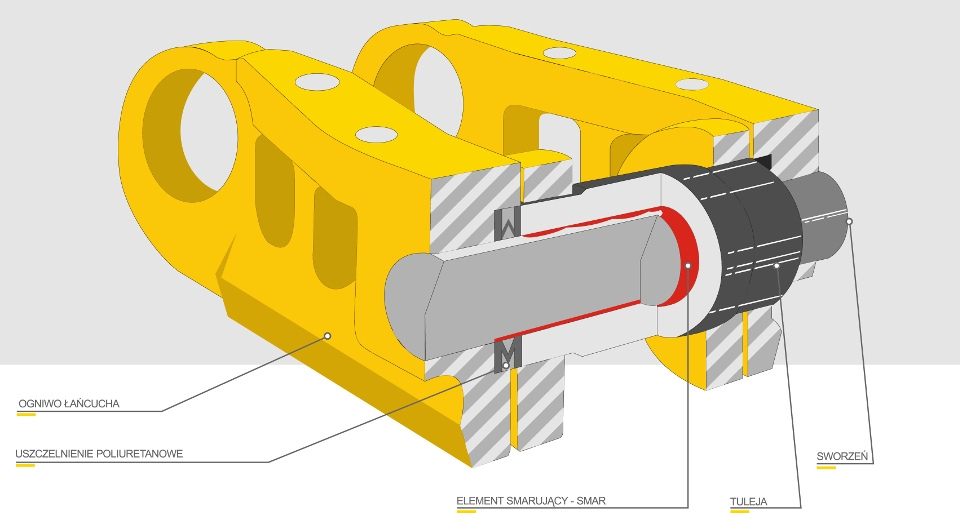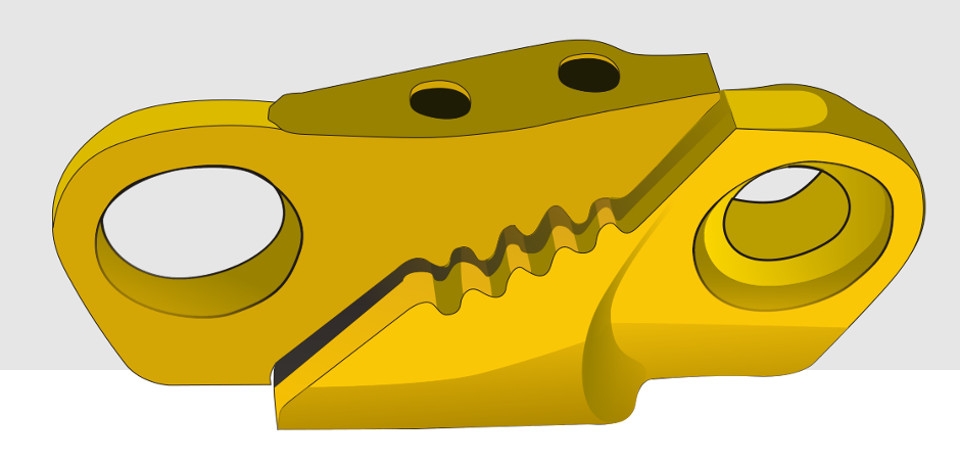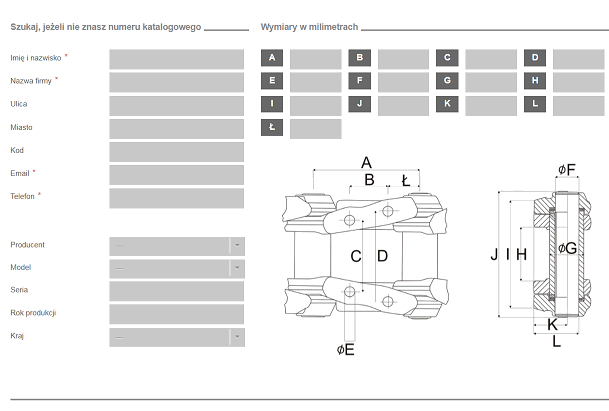Undercarriage parts
Undercarriage parts – track links, track shoes, track rollers, idlers, etc.
Glimat Sp.z o.o. is an exclusive authorized distributor of USCO SpA (the owner of the ITR brand) in Poland. The company with its headquarters in Modena is recognized as one of the vital and most successful producers of spare parts for earth moving machines. The manufacturing capability, many years’ experience and the location of production centres on six continents have entitled the USCO Group to be called the leading producer of earth moving machines (OEM) as well as spare parts for them.
UNDERCARRIAGE FOR CRAWLER MACHINES - TECHNICAL INFORMATION
OPERATIONAL USE
Significant costs of operation and maintenance of crawler machines arise from the undercarriage. One weak track link section in a system may cause a problem, hence, all elements of ITR undercarriage are designed as a whole unit. All components are carefully adjusted in the field of hardness, tolerance, material resistance and limits of the wear & tear in order to achieve an optimal cycle of use of a product. Despite the fact wear & tear factors must not be omitted, life of a product can be extended and consequently, costs of maintenance can be reduced. Maintain your undercarriage system in a good technical condition using certified parts manufactured by ITR.
WHAT CAUSES THE WEAR & TEAR AND HOW TO MANAGE THE undercarriage SYSTEM?
Due to understanding of factors causing the wear & tear and due to periodic inspections of the wear & tear of key components we can get information necessary to make possibly best decisions.
Components of the undercarriage:
1. Track links are forged from special alloy of the boron and steel, and they are deeply-inductive quenched.
2. Pins and bushings are accurately processed by machinery, they are inductive-quenched and protected from being grind.
3. Track shoes are quenched (centrally / indirectly) in order to assure maximal life of a product.
4. Track rollers are made from special alloy of the boron and steel, and then, they are centrally or inductive-quenched in order to extend life of a product.
5. Top rollers are inductive quenched.
6. Sprockets are forged and inductive-quenched in order to get max. resistance and a long life cycle of a product.
7. Idlers - front and rear ones are inductive-quenched.
NON-GREASED track links - EXCAVATORS

Non-greased track link comprises opposite track link sections connected by means of a bush and a pin. Spring- steel cone washers are placed in an opposite track link sections and they connect with each other at the ends of a bushings, when links are connected together. Spring-steel cone washers operate as a seal in order to reduce the wear & tear of a material between the pins and bushings.
As an effect of inside wear & tear of a pin and a bushing, distance from a track link pin to the center of subsequent pin grows up. We call it a "pitch stretch". Along with the pitch stretch, there comes the wear & tear of the outside part of bushings and sprockets teeth. Excavator track links are connected by means of a master pin.
Most of manufacturers of excavators has been giving up a sealed non-greased track link and selects sealed track link filled with grease.
Greased track links - EXCAVATORS

Sealed and filled with grease track links have opposite links. They are equipped with special polyurethane M shape seals. A seal keeps the grease inside the pin and a bushing connector and it prevents from the wear & tear. This track link has grease between a pin and a bushing. Usually it is grease with certain quantity of the molybdenum or the lithium. It improves operation of a product due to reduction of inside friction between a pin and a bushing. Sealed and greased track link is characterized by lower resistances and lower noise rate during the operation. During assembly the grease is pressed in between a pin and a bushing till the space is filled. Life of a sealed and greased track link is by approx. 20 - 40% longer compared to a non-greased chain. When reversed, pins and connectors of bushings may be covered with fresh grease. Excavator track links are connected by means of a master pin.
lubricated track links - BULLDOZERS

Sealed and lubricated track links have opposite links. They have polyurethane seals and they are connected with each other at the ends of a bushing, when links are connected. Polyurethane seals keep the oil between pins and bushings and they protect from the wear & tear. Lubrication assures oil continuity between inside areas of a pin and a bushing, reducing friction and eliminating inside wear & tear of a pin and a bush. Elimination of the pitch stretch slows down the wear & tear of a sprocket as well as the outside dimensions of a bushing. Cycle of the wear & tear of lubricated and sealed track link is by approx. 50% longer compared to a non-greased one. Sealed and greased track link reduces the wear & tear of outside dimensions of bushings and sprockets teeth and it also reduces noise and increases efficiency of a machine.
Lubricated track links, intended for bulldozers are connected by means of a link - SPLIT MASTER LINK.
A LINK - SPLIT MASTER LINK

FACTORS HAVING AN IMPACT ON THE WEAR AND TEAR
The undercarriage operates as a system. When a machine moves there takes place a normal wear & tear which cannot be avoided. When the undercarriage is maintained in a good technical condition and proper operation manners are applied, level of the wear & tear can be reduced.
Maintenance of the undercarriage:
- Track link tensioning or deflecting it (proper deflection equals approx. 50mm /+- 5 mm)
- Width of the track shoe.
The most significant controlled factor in the field of the wear & tear of a undercarriage is proper tensioning of the track link. Proper deflection for all of conventional caterpillars equals approx. 50mm (+-5mm). E.g. a caterpillar in 80 hp machine and deflection equal 12 mm will has a tension of rate equal 2540 kg in case of a measurement in a crawler track link adjuster. The same machine with suggested deflection 50mm will have a tension rate equal 362 kg. Tensioned track group increases a pressure (load), which causes extended wear & tear at the crawler bushings at the time of contact with the sprocket teeth, and in case of a contact - the track link - idler- rollers. Increased wear & tear takes place also when two points have a contact with each other: track link – idler and track link - a roller. Larger weight means also more extensive wear & tear in the entire undercarriage system. Tensioned track group requires also higher power and it generates larger consumption of a fuel.
Measurement of track group's tension:
We move a machine forward slowly, we allow it to stop independently, we align a pin of a track group over the upper roller. We lean a blade / an object on a track groupr. We measure an overhang at the lowest point.
Width of a track shoe makes a difference.
We select possibly narrow one. Wide plates applied on a hard area will cause increased load on connections of pins and bushings and finally, they may cause the wear & tear of pins and bushings. Also integrity of sealing of the track link may be deteriorated. Track shoe, which is wider than necessary one, increases also the load on the idlers, rollers and sprockets. The wider shoes and harder base is, the quicker wear & tear; track shoes, pins, bushings, rollers and idlers are subject to quick wear & tear. Main reason for a loose track shoe and breaking a link away is improperly tightened chassis.
USE OF THE MACHINE
Wear & tear of particular components of the undercarriage depends also on the way a machine is operated. Due to reasonable procedures operation of the undercarriage can be extended.
We reduce unproductive and quick movement of equipment.
Quick operations / movements increase consumption of the undercarriage elements. Consumption of a track link is proportional to the speed. Also distance the machine moves determines its wear and tear. We plan works in such a way to assure the most productive movement of the equipment.
We need to reduce backward run.
The backward run accelerates wear & tear of a track link bushing, which is opposite to a run direction, and of the sprocket’s teeth. Bushings rotate opposite to teeth of the sprocket only in case of the backward run. During the backward run, approx. 75% of pins and bushes are pressed (loaded) and they operate, from the lower edge of the front idler to the first pin and a bushing in contact with a tooth of the sprocketl. Stay careful to make productive movements. Forward movements cause 25% pressure (load) on pins and connections of bushings when a machine operates.
Use selectively shields protecting from stones.
Shields at the length of the entire track link are not required under normal conditions of operation. If we work on a soil or on areas, where shields catch material between track rollers and the crawler track link, we will cause reduced operation cycle of the undercarriage. We use shields when we work on stones and the material does not penetrate the space between the sprocket's teeth and track link bushings or between track links and a thread of idlers. Shields will help also to lead the track groups when driving extremely uphill.
Plan your turns.
Continuation of one-direction turns reduces the track link life cycle. Teeth of the sprocket as well as bushings, track links, idlers, rollers' flanges and area of the thread at the side of constant load will wear and tear more quickly. We plan work in such a manner to turn machine both sides equally.
We frequently wash the undercarriage.
We need to remove soil and debris from the undercarriage, washing it as frequently as it is possible. Clogging a track group with processed material disables proper co-operation of elements such as teeth of the sprocket and the track link bushings. It may cause increased load of the undercarriage and its higher consumption rate.
We operate acc. to conditions of a particular area.
We plan our work and machine's movements in such a way to adjust them to the conditions of a particular area. Operation on a hill (uphill) makes that most of weight stays at the machine rear part. It causes higher load on rear rollers and increased consumption of the sprocketl's teeth and consumption of the front - driving part of the bushing. The load will be small when driving downhill. Operation on a hill (downhill) makes that most of weight stays at the machine front part. Additional load will be located at the front idler, area of thread of this idler and at track links. When pulling back uphill, a bushing rotates reversely to the tooth of the sprocket. There also takes place serious load and a movement between the bushing and teeth of the sprcket, which promotes consumption. Serious load is transferred to all pins and connections of bushings from the bottom edge of the front idler to the first bushing at the point of contact with teeth of the sprocket. Additional load is also transferred between teeth of the sprocket and the track link & areas of the sprockets thread. Life of the bushings, sprockets, track links, rollers and idlers is reduced. Work at a hill (side hill) transfers weight of the machine to the bottom/lower part of the machine and it causes consumption of the rollers' flanges, edges of track links and ends of track shoe grousers. We equalize consumption between both sides of the undercarriage by change of operation direction at a hill.










